
Explaining Pakistan’s Strikes in Afghanistan
2024-03-192043 view
On March 18, Afghanistan’s de facto Taliban rulers said that Pakistani aircraft had bombed civilian targets in the eastern Afghan provinces of Paktika and Khost, killing eight people, all of them women and children. The attacks struck two locations near the Pakistani border, in the Taliban’s Pashtun-majority heartland: Barmal district in Paktika province, and Spera district in Khost province. The two Afghan regions border Pakistan’s South Waziristan and North Waziristan provinces, respectively.
The bombings came a day after Pakistan’s new President Asif Ali Zardari pledged to avenge the killing of seven Pakistani soldiers, including two officers, in an attack in North Waziristan claimed by the Gul Bahadur faction of the Pakistani Taliban, whose leader Hafiz Gul Bahadur is based in Afghanistan.
Tensions between Afghanistan and Pakistan date back to the 19th century. Their shared border, known as the Durand Line, was the result of an 1883 agreement between Afghan King Abdul Rahman Khan and British Commissioner Mortimer Durand, which carved out large Pashtun-majority areas from what had been southern and southwestern Afghanistan, and placed them under British colonial rule as part of the Raj.
After Pakistan gained independence, its government refused to redraw its borders to allow Afghanistan to recover these areas, which are now located in the Pakistani provinces of Khyber Pakhtunkhwa and Balochistan. As a result, in 1947, Afghanistan was the only Muslim country that opposed allowing Pakistan to join the United Nations.
Since the Taliban seized back control of Afghanistan in August 2021, tensions have escalated again, owing in large part to the growing activity of jihadist groups inside Pakistan. As its relations with the Afghan Taliban deteriorated, Islamabad has exerted various means to pressure it into cooperating to dismantle these groups. This pressure has included closing the border several times throughout 2022 and 2023, as well as a Pakistani campaign to repatriate all the Afghan refugees on its territory. According to Human Rights Watch, it forced more than 375,000 Afghans to leave between mid-September and late November 2023 alone.
Afghanistan’s de facto rulers maintain that they have no organizational relationship with the Pakistani Taliban. However, Pakistan’s security services say the two groups cooperate on financing, training and recruitment, and that between 5,000 and 6,000 members of the Pakistani Taliban hail from the Afghan provinces of Paktika and Khost. It should be noted that the border is highly porous; Pashtuns in the area cross via unofficial routes on a daily basis.
Yet despite Pakistan’s violation of Afghanistan’s airspace, the Taliban is unlikely to escalate. That said, it may escalate diplomatically against Islamabad, by drawing attention to the “failures of the Pakistani security services” to prevent attacks and by arguing that Pakistan should not blame Afghanistan for its own failures to secure its territory.
The strikes are however likely to further disrupt Pakistani-Afghan relations, possibly leading to more skirmishes on their shared border, on the pretext of preventing smuggling or attempting to detain infiltrators from the opposing side.
It is noteworthy that alongside the strikes in March, Pakistani officials have been stepping up contacts with the Afghan Taliban leadership, mediated by Pakistani religious scholars. This includes March visits by the Pakistani Chargé d’Affaires in Kabul to Mullah Shirin Akhund, the governor of southern Kandahar and a close associate of the Taliban’s leader, and to Maulana Fazl Rahman, the head of the Association of Islamic Scholars of Afghanistan (not to be confused with the Pakistani politician of the same name). These visits to Kandahar reportedly aimed to explore ways to normalize relations between the two parties and resolve the problem of the Pakistani Taliban by peaceful means.
It is possible that the March airstrikes were part of a stick-and-carrot campaign to pressure the Afghan Taliban into disclosing the locations of Pakistani Taliban commanders, to whom Islamabad accuses the Afghan Taliban of providing arms and refuge.
These tensions will not have escaped the notice of the Islamic State group in Khorasan, which may try to exploit the situation to strengthen its own presence in the region. It may, for example, leak the locations of Pakistani Taliban commanders or step up attacks on Pakistani security and army personnel, attempting to trick the Pakistani authorities into attributing them to the Taliban - Pakistani or Afghan. This could lead to a further deterioration in the already tense border region.





